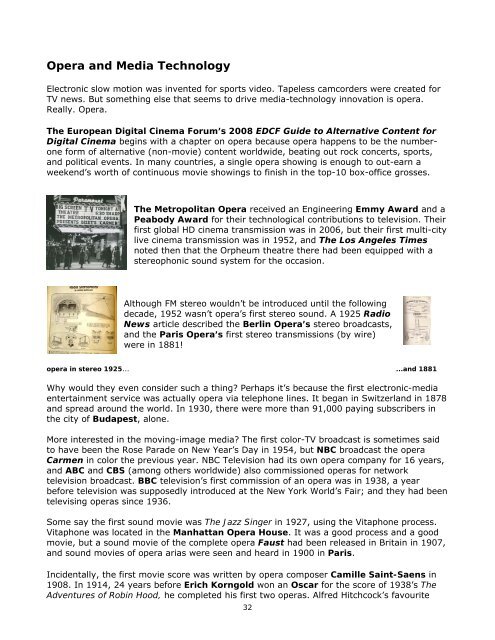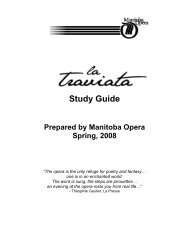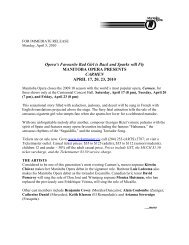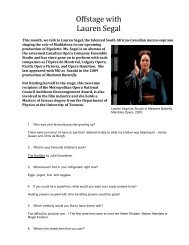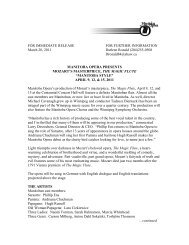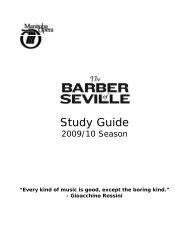You also want an ePaper? Increase the reach of your titles
YUMPU automatically turns print PDFs into web optimized ePapers that Google loves.
<strong>Opera</strong> and Media Technology<br />
Electronic slow motion was invented for sports video. Tapeless camcorders were created for<br />
TV news. But something else that seems to drive media-technology innovation is opera.<br />
Really. <strong>Opera</strong>.<br />
The European Digital Cinema Forum’s 2008 EDCF <strong>Guide</strong> to Alternative Content for<br />
Digital Cinema begins with a chapter on opera because opera happens to be the numberone<br />
form of alternative (non-movie) content worldwide, beating out rock concerts, sports,<br />
and political events. In many countries, a single opera showing is enough to out-earn a<br />
weekend’s worth of continuous movie showings to finish in the top-10 box-office grosses.<br />
The Metropolitan <strong>Opera</strong> received an Engineering Emmy Award and a<br />
Peabody Award for their technological contributions to television. Their<br />
first global HD cinema transmission was in 2006, but their first multi-city<br />
live cinema transmission was in 1952, and The Los Angeles Times<br />
noted then that the Orpheum theatre there had been equipped with a<br />
stereophonic sound system for the occasion.<br />
Although FM stereo wouldn’t be introduced until the following<br />
decade, 1952 wasn’t opera’s first stereo sound. A 1925 Radio<br />
News article described the Berlin <strong>Opera</strong>’s stereo broadcasts,<br />
and the Paris <strong>Opera</strong>’s first stereo transmissions (by wire)<br />
were in 1881!<br />
opera in stereo 1925... ...and 1881<br />
Why would they even consider such a thing? Perhaps it’s because the first electronic-media<br />
entertainment service was actually opera via telephone lines. It began in Switzerland in 1878<br />
and spread around the world. In 1930, there were more than 91,000 paying subscribers in<br />
the city of Budapest, alone.<br />
More interested in the moving-image media? The first color-TV broadcast is sometimes said<br />
to have been the Rose Parade on New Year’s Day in 1954, but NBC broadcast the opera<br />
<strong>Carmen</strong> in color the previous year. NBC Television had its own opera company for 16 years,<br />
and ABC and CBS (among others worldwide) also commissioned operas for network<br />
television broadcast. BBC television’s first commission of an opera was in 1938, a year<br />
before television was supposedly introduced at the New York World’s Fair; and they had been<br />
televising operas since 1936.<br />
Some say the first sound movie was The Jazz Singer in 1927, using the Vitaphone process.<br />
Vitaphone was located in the Manhattan <strong>Opera</strong> House. It was a good process and a good<br />
movie, but a sound movie of the complete opera Faust had been released in Britain in 1907,<br />
and sound movies of opera arias were seen and heard in 1900 in Paris.<br />
Incidentally, the first movie score was written by opera composer Camille Saint-Saens in<br />
1908. In 1914, 24 years before Erich Korngold won an Oscar for the score of 1938’s The<br />
Adventures of Robin Hood, he completed his first two operas. Alfred Hitchcock’s favourite<br />
32


